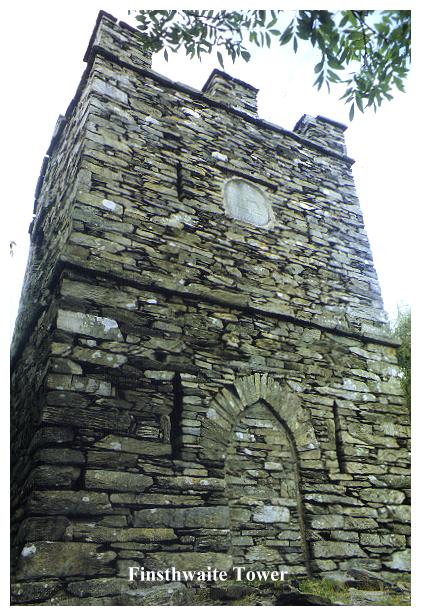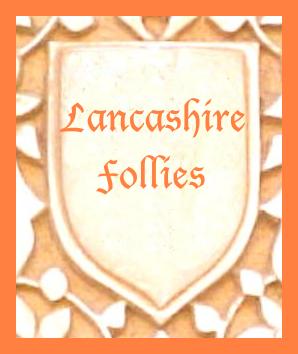13. FINSTHWAITE TOWER
This rough grey-walled tower is literally the 'high point' of a steep, predominantly woodland walk starting near the outlet of Lake Windermere. It features a preserved railway, a pleasant village and some fine views of the southern Lake District.
Getting There: From the M6 junction 36, follow the A591 towards Kendal. Near Sedgwick, turn off onto the Barrow Road (A590) and follow it to Newby Bridge. Park behind the hotel or beside the road leading out to Finsthwaite, just beyond the railway bridge.
Distance: 5 miles
Map ref: SD 365 864 or SD 369 865
Rating: Walk ** Follies and General Interest *
At Newby Bridge we are actually in the Lake District. Other walks in this book flirt with it, but here, at the outfall of Lake Windermere, we are actually in Lakeland proper. This should come as no surprise, for Coniston and Hawkshead once belonged to Lancashire.
Newby Bridge is where Lake Windermere becomes the River Leven, a lively, rushing river soon fated to be lost in the creeks of Morecambe Bay. At its heart is the old five-arched bridge itself and the adjacent Swan Hotel, which American novelist Nathaniel Hawthorne described in glowing terms when he visited it in 1855. The original bridge over the Leven was a wooden one, which in 1651 was found to be 'in great decay', a petition being sent by local worthies to the Bench of Justices in Lancaster appealing for a stone bridge - estimated cost 90 pounds.
Newby Bridge's other attraction is the Lakeside and Haverthwaite Railway. This preserved remnant is all that now remains of a railway line which once connected the steamships of Barrow with the steamships of Windermere. Today only three and a half miles of track and three stations remain, but the line still connects with the Windermere Iron Steamship Companies' summer ferries up the Lake to Bowness.
Our walk to Finsthwaite Tower begins beyond the railway bridge. I followed the route described in Baddeley's Guide to the Lake District, and the directions still hold good. Finsthwaite Tower stands 400 feet upon the summit of a steep and thickly-wooded bluff, with fine views up Lake Windermere - or so Baddeley's description leads us to believe. In reality, the steep slog up from Newby Bridge rewards us with a grey tower completely lost in dense woodland. No doubt there is an excellent view from the top of the tower, the only trouble is that it is little more than a shell and the door is walled up. A fine prospect may be enjoyed from a rocky outcrop a bit lower down the slope, but otherwise the hillside is so thickly cloaked with woods that views in any direction are completely shut out.
What the woods deny you in views, they make up for in quality. The woodlands hereabouts comprise mainly of birches, beeches and Scots pines. The beeches have been heavily coppiced, and this gives the wood an untidy, jungle-like quality. The wood is looked after by the Lake District Society for the Protection of Birds. There are, I am informed, deer hereabouts, which does suggest that perhaps Finsthwaite Tower is not subject to frequent human visitation. On the woodland floor, boletes are in evidence, along with numerous examples of the usually uncommon Stinkhorn. This marvellously clever fungus has a fruiting body which gives off an offensive stink of rotting carrion, attracting flies in great numbers. These settle on the fungus and carry off its spores on their feet.
Finsthwaite Tower (formerly known as the Pennington Lodge Tower) was built by James King of Finsthwaite House in 1799. Its inscription (in the South facing wall) informs us that it was:
ERECTED
To Honor The
Officers, Seamen and marines
Of The
ROYAL NAVY
Whose Matchless Conduct, and
irresistible valour, decisively defeated
the fleets of France, Spain, and Holland
and preserved and protected
LIBERTY AND COMMERCE
1799
The victories referred to were at St. Vincent, Camperdown and The Nile in 1797, which was known as the 'year of victories'. The tower was obviously intended to be a viewpoint, and it is sad that it no longer fulfills this function.
From the tower we follow a potentially confusing path, which eventually leaves the woods and takes us across pastures to the charming village of Finsthwaite. Finsthwaite had a church in 1724, but the present church is Victorian, its rugged solidity making it the winner of a competition for the best 'small church in a mountain area'. In the churchyard is buried Clementa Johannes Sobieska Douglas, a lady with a curious name and a potentially curious history, being a reputed daughter of the ill-fated Young Pretender, Bonnie Prince Charlie. Here, no doubt, is an interesting tale - assuming the story is true.
From Finsthwaite we follow a footpath which leads over pastures back to Newby Bridge, with fine Lakeland views behind us. After entering the woods, we cut off to the right to join the bridleway which leads down to the Finsthwaite lane, entering it between Waterside House and the railway. There should be time for a ride on a train or a boat, or simply a pint in Newby Bridge. Whatever the case, as you watch the waters of the Leven swirling over the great weir at the outfall of England's largest lake, you will feel the satisfaction of having completed an enjoyable walk - and all of it in Lancashire, Whatever the Boundaries Commission might say!











